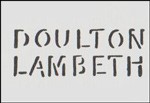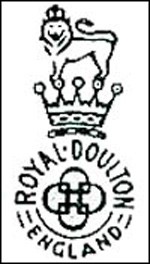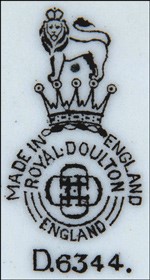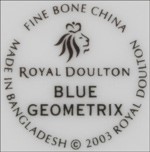At Potteries Auctions, we have been successfully selling Royal Doulton pottery for over 25 years. If you’re looking to expand your collection, or want to auction your collectable Royal Doulton pieces, then we can help. Our experts can help you curate the perfect collection of valuable Royal Doulton for your family to treasure. Our Royal Doulton markings guide can help you identify valuable and collectable Royal Doulton figurines, character jugs and beautiful pottery pieces. Read on to find out more!
What is The History of Royal Doulton Pottery?
Royal Doulton originally had its first factory in Lambeth, London, in 1815, primarily creating pipes and utilitarian wares. John Doulton, the founder, is rumoured to have spent his life savings, £100, on the first factory.
However, in 1882, the company moved north with the focus on crafting fine bone china tableware and decorative items, and so Royal Doulton moved to Staffordshire to be part of the pottery revolution. Royal Doulton pottery has since been based in the heart of The Potteries, with a factory in Burslem, Stoke-on-Trent.
It was in 1901 when Royal Doulton became officially ‘royal’, as it received a royal warrant and permission to use ‘royal’ in the name. Their exquisite, handcrafted pottery pieces have now been decorating houses for centuries.
Why is Royal Doulton Pottery Famous?
Royal Doulton has become a household name and a British manufacture to be proud of, working with illustrious brands and celebrities to create bespoke collections, such as Gordon Ramsay, Ellen DeGeneres and HemingwayDesign.
Producing ceramics for 200 years, Royal Doulton pottery is famous for its unique style and design. It was, and still is, one of the largest commercial pottery producers, supplying high-quality tableware to department stores and commissioning pieces for embassies, and even the House of Lords.
How Do I Identify Royal Doulton Pottery?
The best way to identify your Royal Doulton is through examining the markings on the bottom of the pieces. These markings are used to distinguish the decade and the value of the pottery. The markings vary because of the illustrious and changing nature of the Royal Doulton business.
Authentic Royal Doulton pottery pieces could be marked with the name:
- Vauxhall Pottery – 1815
- Doulton & Watts – 1820
- Doulton & Watts Lambeth – 1826
- Henry Doulton & Co. – 1846
- Doulton & Co. – 1854
- Doulton Ware – 1871
- Doulton & Co. Burslem – 1882
- Doulton & Co. Ltd – 1899
- Royal Doulton – 1901
- Royal Doulton Fine China – 1955
- Royal Doulton Tableware – 1973
- Royal Doulton Lambeth Stoneware – 1974
- Royal Doulton plc -1993
What Royal Doulton Markings Should I Look Out For?
There are many Royal Doulton marks to look out for – the trademarks, various base marks, pattern codes and numbers. These all signify the authenticity and value of the piece. Here are some markings to look out for:
- Your piece may have an impressed date by the trademark stamp on the base of your pottery (bear in mind some of these can be hard to see!).
- Pattern codes were also printed on the base of Royal Doulton produced between 1928 and 1954. You might find these numbers near the crown symbol of the trademark.
- You might also find an artist’s mark. Each artist has an individual signature that often represents their initials. This mark adds to the personalisation and charm of each Royal Doulton piece.
- Finally, you should be vigilant for the Royal Doulton trademark back stamp. This has changed over the years as you can see from the images below.
Royal Doulton Trademark Back Stamps

You may find early Doulton pieces with the previously mentioned trading names, such as ‘Pinder Bourne & Co’ or ‘P.B’. However, from 1827 to around 1882, basic stamps were impressed into the base of the ceramics, such as the ‘Doulton Lambeth’ stamp above. There may be various such as ‘Doulton Lambeth England’ or ‘Doulton & Watts’.


After 1882, until around 1901 the stamps above were used with the four interlocking ‘D’s’. These can be seen in the centre of these images.

From 1901 until 1922, the most distinguishable Royal Doulton trademark was introduced. It brings together the most common and well recognised designs; the famous interlocking ‘D’s’, the crown, the lion, and the roundel. After 1922 a similar back stamp was used, however it was missing the crown. These pieces are quite rare as it was a mark that was not widely used.
From 1928 the year of production was added. To find that date you would need to add 1927 to the number that lies next to the back stamp.

This marking was used from roughly 1930 until 2000. It has some variations, for example you might find the words “Fine China” or “Bone China”. Some variations have dates, whilst others may not.

This marking was first used around the year 2000 and is still used to this day. Sometimes the markings may say “Made in Indonesia”.
Image source: Antique HQ
How to Spot a Rare Royal Doulton Figure
Limited edition Royal Doulton pieces, denoted by corresponding markings to the base, are likely to be rarer. Among collectors, prototype figures are also particularly sought-after. Markings to the base such as “Design Sample”, “Factory Proof” or “Survey Figure” are great indicators of a prototype piece.
Early pieces are quite uncommon, with examples in good condition being even less so, so naturally an older piece with no cracks, chips or signs of wear is rarer and more valuable. If a small number can be seen to the right of the backstamp, adding 27 to it can help in establishing the piece’s age.
How to Sell Royal Doulton Pottery
The value of your Royal Doulton piece will depend greatly on its condition and markings. Having certificates and original boxes can also increase the value. At Potteries Auctions, we can identify and provide valuations on a wide range of Royal Doulton pieces. Our team can help value your collection, turn you into a collector or advise on how much your Royal Doulton pottery could be worth.
Royal Doulton pieces have been an integral part of every one of our sales since the beginning, and we have a large client base who are interested in buying and wares from this most famous of manufacturers. Our team can help value your collection or turn you into a seasoned Royal Doulton collector!
Please get in touch with us if you’re looking for an expert evaluation and are seeking to sell your Royal Doulton pottery. Free valuation days are held every Tuesday at our Silverdale saleroom – to book an appointment, use our online booking form here. You can also email us at enquiries@potteriesauctions.com or call us on +44 (0)1782 638100. Valuations can even be provided via WhatsApp – simply send some clear images of your items via the app to 07864 667940.
